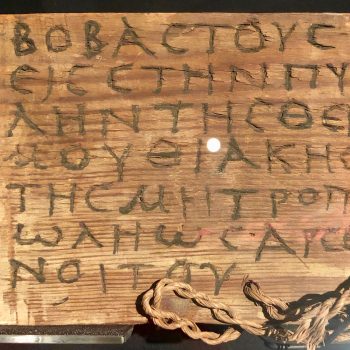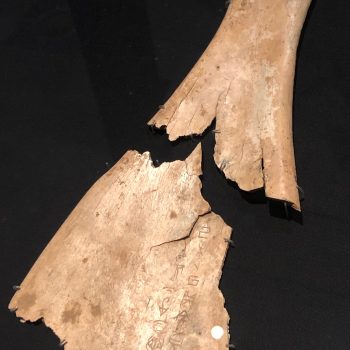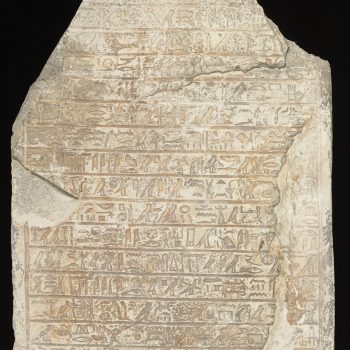Writing – Making Your Mark: New exhibition opens at British Library!

Schoolchild’s homework in Greek on a wax tablet, 2nd century AD. © British Library Board.
The British Library has opened yet another fantastic exhibition devoted to writing and its historical evolution. While its previous foray into book history with Anglo Saxon Kingdoms, (which closed in late February of this year) focused on one specific period, Writing: Making Your Mark offers a broader perspective on the development of language, writing and its future.

This 2,000 year old Greek placard was attached to a mummy with a string to identify the deceased as Bobastous, and to indicate where he was to be buried. The Petrie Museum of Ancient Egyptology. © Sandra Alvarez.
Humans have been writing for well over 5,000 years. This exhibition seeks to answer why and how we write by starting from its very beginnings in Mesopotamia, Egypt, China, and the Americas, to the present and beyond.
The exhibition is partitioned into several different sections, starting with the Origins of Writing to look at who our earliest writers were, how they wrote, where they came from, and why they used writing to communicate.
So why did people turn to writing? Curator of Ancient Manuscripts, Peter Toth, suggested that there were three reasons people began to write: first, people wanted to count things and to keep track of items. The earliest piece in the exhibition that demonstrates this concept comes from Mesopotamia, and is approximately 5000 years old. It contains a list of things with their numbers. Naming things was another important function, evidenced by an ancient Greek placard for a mummy, telling people who that deceased person was, and lastly, “to communicate beyond the physical world, beyond the grave, to the Netherworld, to the Gods, which is illustrated by this little Egyptian sculpture, the Shabti, which contains magical spells on it which enable the Shabti to come to life in the Netherworld and work for the dead”.

Chinese oracle bones. Made of Ox bone, or turtle shell, these bones were used to seek answers from one's ancestors. This particular set is over 3,000 years old. 1300–1050 BC, The British Library. © Sandra Alvarez.
The exhibition then moves onto Writing Systems and Styles, which, Curator Adrian Edwards stated, “looks at the shapes of the marks that we make on the page”. It examines alphabets, demonstrating the origins and evolution of our Roman alphabet. One of the earliest surviving examples of the first stages of the alphabet we use today was carved into the base of the Serabit Sphinx from Sinai, dating to 1800 BC (on loan from the British Museum). According to Edwards, it has Egyptian hieroglyphs on its base, “but those hieroglyphs are not being used in the usual way, they are being used to write a language called Canaanite, and it’s being used alphabetically, so each of the characters being there is being used for its sound value, and it spells out a message. So that is one of the earliest manifestations of the alphabet, and then we track it through and how it developed with the Phoenicians, with the ancient Greeks, the Etruscans in central Italy, through to the Romans themselves.”

Ancient Egyptian Stela c.1600-BC. The oldest item in the British Library! © The British Library Board.
Other pieces of note for ancient history enthusiasts include:
● The oldest artefact in the British Library’s repertoire, a recently discovered 3,600 year old ancient Egyptian limestone monument covered in hieroglyphs, which contains a hymn to the god of the netherworld, Osiris.
● Chinese oracle bones, that were used for divination to seek answers about important affairs such as crops, warfare, childbirth, and weather from one’s ancestors. Until the discovery of the Egyptian limestone monument, these 3000 year old oracles bones were believed to be the oldest pieces in the British Library.
● A 2.44 metre-long papyrus scroll, known as The Ravenna Papyrus, recording the sale of property in Italy from June 3, 572 AD, which is the longest intact papyrus in the British Library, and possibly one of the largest to survive from Ancient and Medieval Europe. It is an excellent example of Later Roman handwriting.
● An ancient wax tablet with a schoolchild’s homework in Greek from AD 100–199.

Sandstone sphinx with early alphabetic inscription_1800 BCE (c) The Trustees of the British Museum.
The exhibition then turns to Materials and Technology, examining the tools and surfaces people used to write, and debunking the myth that we no longer use the same tools and technology as our predecessors. People and Writing examines the social history behind writing, how people learn to write, the process of that learning, and how humans innovated their methods geographically, and centuries. Lastly, the exhibition ends on The Future of Writing, which looks at where we think writing is going and imagines how we will communicate in the years ahead.
Writing: Making Your Mark at the British Library has been curated by Adrian S. Edwards (Head of Printed Heritage Collections), Peter Toth (Curator of Ancient Manuscripts), Emma Harrison (Curator of Chinese Collections) and Michael Erdman (Curator of Turkish & Turkic Collections) at the British Library.
Tickets
Full Price: £14.00
Senior 60+: £12.00
Student / Registered Unemployed / Disabled / National Art Pass / Child 12-17: £7.00
National Art Pass Senior: £6.00
Members / Child 11 and Under: £0.00
Group visits (10 people or more) will receive a 10% discount on their ticket price and introductory talks are available. For more information, please visit www.bl.uk/groups
Love Ancient History? Want to learn more?!
